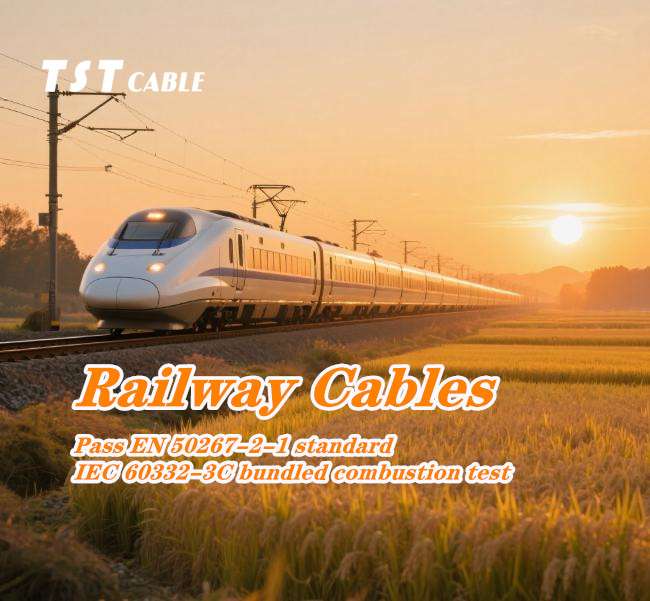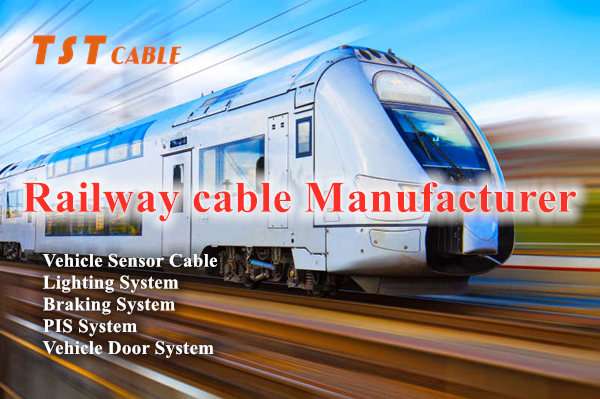
As we ride the smooth subway through the city’s underground, few people realize that behind this seemingly tranquility lies countless precision components silently supporting it. One of the most crucial components is the TST CABLE rail transit locomotive power control cable.it not only transmits power but also ensures the safety and stability of the train. Today, we’ll delve deeper into the wonders of this “invisible hero”!
I. Core Application Scenarios
Traction System
As the core carrier of EMU power transmission, it transmits 2.5kV AC voltage and 3000A peak current between the main converter and the traction motor, requiring 3C certification (GB/T 12528-2008).
Control System
Transmitting critical signals such as the CAN bus, it requires a shielding attenuation of 70dB@100MHz to ensure the precise execution of autonomous driving and braking commands.
Auxiliary Power Supply System
Provides power for air conditioning, lighting, and other equipment. It utilizes a split-screen + overall shielding double-layer structure with an aluminum-plastic composite tape coverage of ≥95%, suppressing high-frequency interference from inverters.
II. From Power to Control: The Dual Mission of TST CABLE Power Control Cables
1. Power Transmission: Breathing Life into the Train
A Heartlike Role: Just as the human heart pumps blood through blood vessels, power control cables transmit electrical energy from the traction substation to key components of the locomotive, particularly those with high power consumption, such as traction motors.
Case Study: On a Beijing subway line, the use of new, high-efficiency power control cables has enabled faster train acceleration and more stable operation, reducing single-trip travel time by approximately 5%.
2. Signal Control: Ensuring Every Command is Accurately Executed
An Extension of the Brain: In addition to providing energy, these cables also transmit various control signals, including but not limited to those for the braking system, door control, and air conditioning. They can be said to be like the train’s nervous system, ensuring the coordinated operation of various subsystems. True Story: There was once a report that a city’s subway system nearly suffered a rear-end collision due to signal delays caused by aging cables. However, after adopting high-quality TST CABLE cables, such issues have never occurred again.
III. Meeting Extreme Challenges: Core Features of TST CABLE Power Control Cables
1. High-Temperature Resistance: A Standout in Fire
Conductor: 99.99% high-purity annealed copper, stranded for enhanced flexibility, with resistance tolerance controlled to ±2% (national standard ±5%).
Insulation: Thin-walled cross-linked polyolefin design (15% thickness reduction), temperature resistance -60°C to 125°C, and passed 2000-hour xenon lamp aging test.
Temperature Challenges: The rail transit environment is complex and changeable, especially in confined spaces. Temperatures inside locomotives can reach over 100°C. This requires cables to possess excellent heat resistance and be able to operate stably and long-term under such harsh conditions. Material Innovation: Some high-end products on the market currently utilize specialized insulation materials, such as TST CABLE silicone rubber or fluoroplastic cables, which not only withstand high temperatures but also effectively resist aging.
2. Flame Retardancy: The Last Line of Defense for Passenger Safety
Flame Retardancy: Passes the IEC 60332-3C bundled combustion test, with a smoke density of ≤1.5dB/m (EN 50267-2-1).
Fire Barrier: In the event of a fire, ordinary cables often become a significant vector for the spread of fire. Therefore, flame retardancy is an essential element in the design of power control cables. Most modern cables undergo rigorous testing and are proven to automatically extinguish when exposed to open flames and produce no toxic fumes.
Success Story: In a Shanghai subway accident, the installation of high-performance flame-retardant TST CABLE cables within the carriages averted a larger-scale disaster. 3. Anti-interference Capability: A Silent Guardian of the Information Age
Anti-interference: Tinned copper wire braided shielding (density ≥85%), bit error rate below 10⁻⁹.
Electromagnetic Protection: With technological advancements, more and more electronic devices are being introduced into the rail transit sector, bringing with them a new challenge: electromagnetic interference. To ensure accurate data transmission, power control cables often incorporate a shielding layer, forming a solid barrier.
Technological Breakthrough: Some brands have even developed cables with adaptive adjustment capabilities, automatically adjusting shielding effectiveness based on changes in the surrounding electromagnetic environment, further enhancing system reliability.
IV. Significant Advantages: Why Choose TST CABLE’s High-Quality Power Control Cables?
1. High Reliability: The Secret Weapon to Reduce Failures
Quality Assurance: High-quality cables undergo a rigorous quality inspection process, from raw material screening to finished product inspection, with strict scrutiny at every step. This not only reduces the likelihood of problems during use but also extends the product’s lifespan.
Practical Benefits: Statistics show that using high-reliability cables reduces rail transit system maintenance costs by an average of approximately 20%, significantly improving operational efficiency. 2. Environmental Protection and Energy Saving: The Hidden Drivers of Green Travel
Low-Carbon Concept: With growing global awareness of environmental protection, many manufacturers are focusing on energy conservation and emission reduction in their production processes. Some new cables utilize environmentally friendly insulation materials, meeting functional requirements while minimizing environmental impact.
Long-Term Planning: In the long run, this approach not only helps protect our planet but also lays a solid foundation for sustainable business development.
3. Easy Installation and Maintenance: A Time-Saving and Labor-Saving Option
Humanized Design: Given the limited on-site construction conditions, modern power control cables are designed with greater emphasis on practicality and convenience. For example, some TST CABLE models feature lightweight construction for easy handling, while others feature eye-catching color coding for easier maintenance.
User Feedback: According to a senior engineer, since switching to new TST CABLE cables, their work efficiency has increased by at least 30%, significantly shortening project times.
In this era of pursuit of speed and efficiency, rail transit, as a vital component of urban transportation networks, is continuously moving towards intelligent and green development. All these achievements are inseparable from the “behind-the-scenes heroes” like TST CABLE power control cables. Although they are unknown, they protect the safety and comfort of every passenger in their own way.
Also available in:
English




